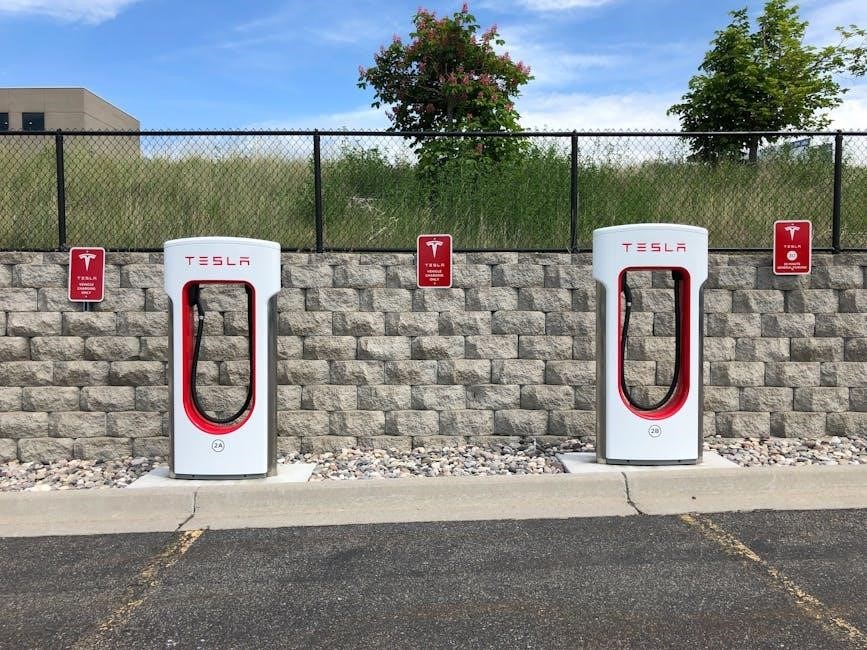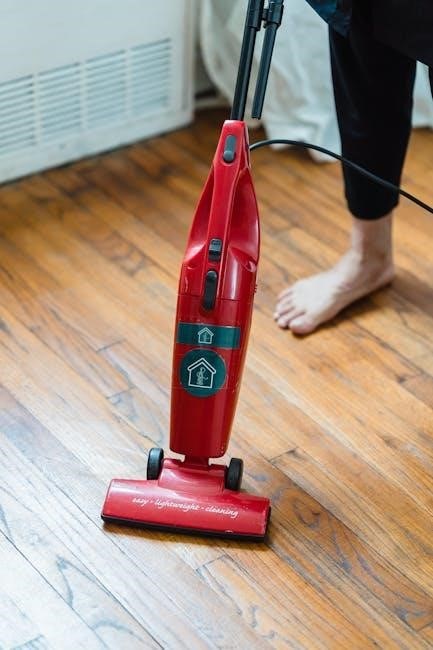Welcome to the American Farmworks Electric Fence Manual‚ your comprehensive guide to understanding and effectively using electric fencing systems for livestock management and property security․
1․1 Overview of the Manual
This manual provides a detailed guide to understanding‚ installing‚ and maintaining American Farmworks electric fencing systems․ It covers essential components‚ safety protocols‚ and troubleshooting tips to ensure optimal performance․ Designed for farmers‚ ranchers‚ and property owners‚ the manual offers practical advice for managing livestock and securing property effectively․ Topics range from energizer functions to fence wire conductivity‚ ensuring a comprehensive understanding of electric fencing․ With clear instructions and visual aids‚ this resource helps users maximize efficiency while adhering to safety standards․ Whether you’re a novice or experienced user‚ this manual serves as an indispensable guide for electric fence management․
- Covers installation‚ maintenance‚ and troubleshooting․
- Includes safety guidelines and best practices․
- Provides detailed component explanations․
1․2 Importance of Electric Fencing
Electric fencing is a vital tool for effective livestock management and property security․ It provides a reliable barrier that deters animals from crossing while ensuring their safety․ Unlike traditional fencing‚ electric systems are cost-effective‚ require minimal maintenance‚ and are highly durable․ They also offer flexibility‚ making them ideal for temporary or permanent setups․ By creating a psychological barrier‚ electric fences train animals to respect boundaries without causing physical harm․ This method is also environmentally friendly‚ as it minimizes the need for extensive materials․ Additionally‚ electric fencing enhances property security‚ protecting crops and livestock from predators․ Its adaptability and efficiency make it a preferred choice for modern farming and land management․
- Provides effective livestock containment and protection․
- Offers cost-saving and low-maintenance solutions․
- Ensures safety for both animals and humans․

Key Components of American Farmworks Electric Fence
The system includes energizers‚ conductive wire‚ insulators‚ posts‚ and a grounding system‚ ensuring reliable electric fencing for livestock control and property protection․
2․1 Energizers and Their Functions
The energizer is the core of the American Farmworks Electric Fence system‚ responsible for converting power into high-voltage electric pulses․ These pulses deter animals from crossing the fence․ Energizers are available in solar‚ battery‚ or AC-powered models‚ catering to different power needs․ They store electrical energy in capacitors and release it in timed intervals‚ ensuring efficient operation․ Proper installation and grounding are critical for optimal performance․ The energizer’s output voltage and pulse rate are key factors in maintaining an effective barrier․ Always choose the right model based on fence length and animal type for maximum efficiency and safety․
2․2 Fence Wire and Conductivity
The fence wire is the conductor that carries the electric pulse from the energizer․ American Farmworks offers various types‚ including polywire‚ polytape‚ and high-tensile wire‚ each designed for durability and conductivity․ Proper wire tension is essential to maintain consistent voltage along the fence․ Conductivity depends on the material; stainless steel and aluminum wires are excellent for efficient energy transfer․ Regular inspection is crucial to ensure no vegetation or debris causes shorts‚ which can reduce system effectiveness․ Clean‚ well-maintained wire ensures optimal performance and safety for both animals and people․ Always select the right wire type for your specific fencing needs․ Grounding is also a critical factor for proper conductivity․
2․3 Posts and Insulators
Posts and insulators are critical components of an electric fence system‚ ensuring proper functionality and safety․ Posts‚ typically made of wood‚ steel‚ or fiberglass‚ provide structural support and maintain the fence’s alignment․ Insulators‚ attached to the posts‚ prevent the electric current from being grounded‚ ensuring the energy flows through the wire․ American Farmworks offers durable insulators designed for various fence types‚ such as ceramic or plastic models․ Proper installation is key to avoid shorts and maintain consistent voltage․ Regularly inspect insulators for wear or damage and replace them as needed to ensure optimal system performance and longevity․ Securely fasten insulators to posts to prevent shifting․ Keep insulators clean to avoid energy loss․ Always use insulators designed for your specific fencing application to guarantee reliability and safety․ Insulators are essential for maintaining the effectiveness of the electric fence system․ Proper installation and maintenance ensure the system operates efficiently․ Posts should be spaced appropriately to support the fence without sagging․ Insulators must be compatible with the type of wire used to prevent energy loss․ Always follow the manufacturer’s recommendations for selecting and installing posts and insulators․ This ensures the electric fence functions correctly and remains safe for both animals and people․ Regular inspections help identify and address potential issues before they escalate․ Cleaning insulators periodically removes dirt and vegetation that could interfere with conductivity․ Replace worn or damaged insulators promptly to maintain the integrity of the fence․ By prioritizing the quality and condition of posts and insulators‚ you ensure a reliable and efficient electric fencing system․ Insulators should be tightly secured to posts to prevent movement or loosening over time․ Avoid using makeshift materials that could compromise the system’s performance or safety․ Always adhere to the guidelines provided in the manual for installing and maintaining posts and insulators․ This ensures the electric fence remains effective and durable for years to come․ Insulators are a vital link in the electric fencing system‚ and their proper installation and upkeep are essential for optimal functionality․ By following the manufacturer’s instructions and performing regular maintenance‚ you can ensure your electric fence operates efficiently and safely․ Posts and insulators work together to create a secure and reliable barrier for managing livestock or protecting property․ Their proper installation and care are fundamental to the success of the electric fencing system․ Always use high-quality materials and follow the recommended practices outlined in the manual to achieve the best results․ Insulators should be inspected regularly for signs of wear or damage‚ and replacements should be made as needed to prevent disruptions in the fence’s operation․ Proper spacing and alignment of posts are also crucial to ensure the fence remains stable and functions as intended․ Insulators must be compatible with the type of wire used to avoid energy loss and ensure consistent voltage along the fence line․ By carefully selecting and maintaining posts and insulators‚ you can create a dependable and long-lasting electric fence system․ Insulators play a key role in directing the electric current along the fence wire without grounding it․ They are essential for maintaining the effectiveness of the fence and ensuring the safety of both animals and people․ Always use insulators designed for your specific fencing needs and follow the installation guidelines provided in the manual․ Regular inspections and maintenance will help extend the life of your electric fence and ensure it continues to perform optimally․ Posts provide the structural foundation for the fence‚ while insulators ensure the electrical current flows correctly․ Together‚ they are vital for the overall functionality and safety of the electric fencing system․ Proper installation and upkeep of posts and insulators are essential for achieving a reliable and efficient fence․ Always refer to the manual for detailed instructions on selecting‚ installing‚ and maintaining these components․ By doing so‚ you can ensure your electric fence remains effective and safe for years to come․ Insulators are designed to withstand various environmental conditions‚ but they still require regular maintenance to function properly; Clean them periodically to remove dirt and debris that could interfere with conductivity․ Replace any damaged or worn insulators promptly to maintain the integrity of the fence․ Properly securing insulators to posts is crucial to prevent movement or loosening‚ which could disrupt the system’s operation․ Always use high-quality materials and follow the manufacturer’s recommendations for the best results․ Insulators and posts are fundamental to the electric fencing system‚ and their proper care ensures the fence’s efficiency and safety․ Regular inspections and maintenance are essential to identify and address any issues before they become major problems․ By adhering to the guidelines in the manual‚ you can ensure your electric fence remains a reliable and effective solution for managing livestock or protecting property․ Insulators are a critical component of the electric fence‚ ensuring the electrical current flows through the wire without being grounded․ They must be installed correctly and maintained regularly to function effectively․ Always use insulators that are compatible with your fence wire and follow the manufacturer’s instructions for installation and care․ Properly secured insulators prevent energy loss and ensure consistent voltage along the fence line․ Regular inspections help identify and address potential issues‚ such as wear or damage‚ before they compromise the system’s performance; By prioritizing the quality and condition of insulators‚ you can ensure your electric fence operates efficiently and safely for years to come․ Insulators are essential for directing the electric current along the fence wire and preventing it from grounding․ They are available in various materials‚ such as ceramic and plastic‚ each designed for specific fencing applications․ Proper installation and maintenance of insulators are crucial for ensuring the fence’s effectiveness and safety․ Always follow the manufacturer’s guidelines for selecting and installing insulators‚ and perform regular inspections to identify and address any issues promptly․ By doing so‚ you can maintain a reliable and efficient electric fencing system․ Posts and insulators are vital components of an electric fence‚ ensuring the system operates safely and effectively․ Posts provide the structural support needed to maintain the fence’s alignment‚ while insulators prevent the electric current from being grounded․ Proper installation and regular maintenance of these components are essential for the overall performance of the fence․ Always use high-quality materials and adhere to the manufacturer’s instructions for installing and caring for posts and insulators․ Regular inspections help identify and address potential issues before they escalate‚ ensuring the fence remains efficient and safe for years to come․ Insulators are a key part of the electric fencing system‚ ensuring the electrical current flows through the wire without being grounded․ They are available in various types‚ such as ceramic and plastic‚ each designed for specific applications․ Proper installation and maintenance of insulators are crucial for the fence’s effectiveness and safety․ Always follow the manufacturer’s guidelines for selecting and installing insulators‚ and perform regular inspections to identify and address any issues promptly․ This ensures the electric fence operates efficiently and safely‚ providing a reliable solution for managing livestock or protecting property․ Insulators and posts are essential components of an electric fence‚ ensuring the system functions correctly and safely․ Posts provide the necessary structural support‚ while insulators direct the electric current along the wire without grounding it․ Proper installation and regular maintenance of these components are vital for the fence’s performance and longevity․ Always use high-quality materials and follow the manufacturer’s instructions for installing and caring for posts and insulators․ Regular inspections help identify and address potential issues before they become major problems‚ ensuring the fence remains efficient and safe for years to come․ Insulators are a crucial part of the electric fencing system‚ ensuring the electrical current flows through the wire without being grounded․ They are available in various materials‚ such as ceramic and plastic‚ each designed for specific fencing applications․ Proper installation and maintenance of insulators are essential for the fence’s effectiveness and safety․ Always follow the manufacturer’s guidelines for selecting and installing insulators‚ and perform regular inspections to identify and address any issues promptly․ By doing so‚ you can ensure your electric fence operates efficiently and safely‚ providing a reliable solution for managing livestock or protecting property․ Insulators are a key component of the electric fence‚ ensuring the electrical current flows through the wire without being grounded․ They are available in various types‚ such as ceramic and plastic‚ each designed for specific applications․ Proper installation and maintenance of insulators are crucial for the fence’s effectiveness and safety․ Always follow the manufacturer’s guidelines for selecting and installing insulators‚ and perform regular inspections to identify and address any issues promptly․ This ensures the electric fence operates efficiently and safely‚ providing a reliable solution for managing livestock or protecting property․ Insulators and posts are vital components of an electric fence‚ ensuring the system operates safely and effectively․ Posts provide the structural support needed to maintain the fence’s alignment‚ while insulators prevent the electric current from being grounded․ Proper installation and regular maintenance of these components are essential for the overall performance of the fence․
2․4 Grounding System
The grounding system is a crucial component of the American Farmworks Electric Fence‚ ensuring the safe operation of the electric fencing․ It completes the electrical circuit by directing the current safely into the earth‚ preventing shock hazards․ Proper installation involves burying multiple grounding rods‚ typically 6-8 feet deep‚ in moist soil to enhance conductivity․ Regularly inspect the grounding rods for corrosion or damage and ensure the surrounding area remains dry to prevent energy loss․ A well-maintained grounding system ensures optimal performance and safety‚ protecting both livestock and individuals from electrical hazards․ Follow the manual’s guidelines for installation and maintenance to guarantee effective grounding․

Installation and Setup
Proper installation ensures the electric fence operates safely and effectively․ Begin by planning the layout‚ then install the energizer‚ wire‚ and posts․ Finally‚ test voltage levels to confirm functionality and safety․
3․1 Planning the Fence Layout

Planning the fence layout is crucial for ensuring optimal performance and safety․ Start by assessing the terrain‚ noting obstacles like trees‚ hills‚ and water sources․ Determine the fence perimeter based on your property size and the type of livestock or area you want to enclose․ Consider the placement of gates and entrances for easy access․ Ensure the layout aligns with your purpose‚ whether it’s for livestock management or property security․ Proper planning helps avoid installation challenges and ensures the electric fence operates efficiently․ Record your design for reference during installation and future maintenance․
3․2 Step-by-Step Installation Guide
Begin by unpacking and organizing all components‚ including posts‚ wire‚ energizer‚ and grounding rods․ Lay out the fence layout as planned‚ marking post locations․ Start by installing corner and gate posts securely․ Next‚ attach insulators to the posts and thread the fence wire through them․ Connect the energizer to the fence wire and ensure proper grounding by burying the grounding rod and connecting it to the energizer․ Test the fence voltage using a tester to confirm it’s functioning correctly․ Refer to the manual for specific diagrams and detailed instructions to ensure a safe and effective setup․
3․3 Testing the Fence
Testing the fence ensures it operates safely and effectively․ Use a voltage tester to measure the electric current along the fence line‚ ensuring it reaches the recommended voltage level․ Check for consistent voltage at intervals‚ especially near corners and gates․ Verify that the grounding system is functioning properly by testing near the grounding rod․ Inspect for any short circuits or wire damage‚ and ensure all connections are secure․ Test the fence with a known conductor‚ like a metal tool‚ to confirm it delivers a shock․ Address any issues immediately to maintain fence performance and animal safety․ Regular testing prevents potential failures and ensures reliability․

Safety Guidelines
Always follow safety protocols when handling electric fencing․ Avoid contact with conductive objects to prevent shocks․ Ensure the fence is clearly marked with warning signs to alert people and animals of its presence․ Keep children and pets away from the fence․ Regularly inspect the system to identify and repair any potential hazards․ Never touch the fence while standing in water or on wet surfaces․ Use proper testing tools to check voltage levels safely․ Display clear warning signs to indicate the fence is electrified․ Follow all manufacturer guidelines to ensure safe operation and avoid accidents․ Proper safety measures protect both people and livestock․
4․1 Precautions for Handling Electric Fencing
When handling electric fencing‚ always prioritize safety to avoid shocks․ Wear insulated gloves and avoid contact with conductive objects like metal tools or jewelry․ Never touch the fence with wet hands or while standing in water‚ as this increases the risk of electrical shock․ Ensure the area is dry before working on the fence․ Use a voltage tester to check for live currents before handling wires․ Keep children and pets away to prevent accidental contact․ Always disconnect the energizer and allow the fence to discharge completely before performing maintenance․ Proper precautions ensure safe handling and minimize risks associated with electric fencing systems․
4․2 Warning Signs and Safety Measures
Always display clear warning signs near electric fences to alert people and animals of potential danger․ Ensure signs are visible and legible‚ indicating the presence of an electric fence․ Never allow children or unauthorized individuals to operate or handle the fence system․ Avoid touching the fence while in contact with conductive materials‚ such as metal tools or jewelry․ Regularly inspect the fence for damage or wear‚ addressing issues promptly to prevent accidents․ Adhere to all safety guidelines outlined in the manual‚ and ensure compliance with local regulations and safety standards‚ such as those set by Underwriters Laboratories (UL)․ Proper safety measures protect both people and livestock․

Troubleshooting Common Issues
This section addresses frequent problems with electric fences‚ such as short circuits‚ low voltage‚ and faulty components․ It provides step-by-step solutions to restore optimal functionality quickly and safely․
5․1 Identifying Short Circuits
A short circuit occurs when the electric fence wire accidentally comes into contact with a conductive object‚ such as vegetation or metal‚ causing a direct path to ground․ This disrupts the flow of electricity‚ reducing the fence’s effectiveness․ To identify short circuits‚ check for unusual voltage drops using a voltage meter or fault finder․ Inspect the fence line for visible damage‚ sagging wires‚ or contact with foreign materials․ Addressing short circuits promptly is crucial to maintain the fence’s performance and ensure the safety of animals and equipment․ Regular inspections and proper maintenance can help prevent such issues from arising․
5․2 Checking Voltage Levels
Checking voltage levels is essential to ensure your electric fence operates effectively and safely․ Use a digital voltage meter to measure the voltage at various points along the fence line․ Ideal voltage levels typically range between 2‚000 to 6‚000 volts for livestock containment․ Place the meter on the fence wire‚ away from the energizer‚ to get accurate readings․ Low voltage may indicate poor grounding‚ vegetation interference‚ or short circuits․ Check the grounding system and ensure it is properly installed with multiple ground rods․ Regular voltage checks help maintain fence performance and prevent issues before they escalate․ Always follow safety guidelines when handling electrical components․
5․3 Repairing Damaged Components
Repairing damaged components of your American Farmworks electric fence is crucial for maintaining its performance and safety․ Begin by identifying the source of the damage‚ such as broken wires‚ insulators‚ or ground rods․ Turn off the energizer before making any repairs to ensure your safety․ Use wire cutters and pliers to remove damaged sections and replace them with compatible parts․ Inspect insulators for cracks and replace them if necessary․ For ground systems‚ ensure all rods are securely connected and free from corrosion․ After repairs‚ reconnect the energizer and test the fence to confirm proper voltage levels․ Regular maintenance prevents further issues and extends the fence’s lifespan․

Maintenance and Upkeep
Regularly inspect and clean fence components to ensure optimal performance․ Check for wear‚ damage‚ or vegetation interference․ Replace worn parts promptly to maintain efficiency and safety․
6․1 Regular Checks and Inspections
Regular checks are essential to ensure your electric fence operates efficiently․ Inspect fence wires for damage‚ wear‚ or corrosion․ Verify insulators are secure and undamaged․ Check the grounding system to ensure proper connectivity and prevent voltage loss․ Look for vegetation interference‚ as it can reduce fence effectiveness․ Test voltage levels periodically using a voltage tester to confirm the system is functioning within safe and effective parameters․ Address any issues promptly to maintain reliability and safety․ Routine inspections help prevent costly repairs and ensure your electric fence remains a secure and durable solution for livestock management and property protection․
6․2 Cleaning and Replacing Components

Regular cleaning and inspections ensure optimal performance of your electric fence․ Clean fence wires and components to remove dirt‚ rust‚ or vegetation that may reduce conductivity․ Use a wire brush or mild detergent to clean surfaces․ Inspect insulators‚ energizers‚ and grounding rods for wear or damage․ Replace any damaged or corroded parts immediately to maintain efficiency․ Ensure all connections are secure and free from debris․ Replace worn-out components with compatible parts from American Farmworks to avoid compatibility issues․ Regular maintenance prevents voltage drops and ensures reliable operation‚ safeguarding both your livestock and property․ Always follow the manual’s guidelines for replacement and cleaning․

Optimizing Electric Fence Performance
Optimizing your American Farmworks electric fence performance involves ensuring maximum energy transfer‚ proper wire tension‚ and using high-quality materials to maintain efficiency and effectiveness․
7․1 Ensuring Maximum Efficiency
Ensuring maximum efficiency in your American Farmworks electric fence system requires proper installation‚ regular maintenance‚ and optimal component selection․ Start by selecting high-quality materials‚ such as durable fence wires and insulators‚ to minimize energy loss․ Proper grounding is critical‚ as it ensures the electrical current flows effectively․ Regularly check voltage levels using a reliable tester to identify and address short circuits or weak spots․ Additionally‚ keep vegetation trimmed to prevent interference with the fence wire․ Finally‚ follow the manufacturer’s guidelines for energizer capacity and spacing to ensure the system operates at peak performance‚ maximizing its effectiveness for livestock control and property security․
7․2 Avoiding Common Mistakes
When installing and maintaining an American Farmworks electric fence‚ avoiding common mistakes is crucial for optimal performance․ One of the most frequent errors is improper grounding‚ which can significantly reduce the system’s effectiveness․ Ensure the grounding system is well-maintained and free from corrosion․ Another mistake is using low-quality or incompatible materials‚ such as thin or poorly insulated wires‚ which can lead to energy loss and short circuits․ Additionally‚ neglecting regular inspections and voltage checks can result in undetected issues․ Always follow the manufacturer’s guidelines‚ avoid overloading the fence with excessive wire‚ and keep the fence clear of vegetation to maximize efficiency and longevity․

American Farmworks Electric Fence Models
American Farmworks offers a range of electric fence models designed for durability and efficiency․ Each model is tailored to specific needs‚ ensuring reliable livestock control and property security․
8․1 Overview of Popular Models
American Farmworks offers a variety of electric fence models to suit different needs․ The 1568524 Electric Fence Energizers are among the most popular‚ known for their durability and efficiency․ These models are designed to handle medium-sized pastures and provide reliable livestock control․ Other notable models include the Zareba Elite Electric Polybraid Fence‚ which combines strength and conductivity for optimal performance․ Each model is engineered to ensure long-lasting reliability‚ making them ideal for farmers and property owners seeking effective electric fencing solutions․ These products are backed by comprehensive manuals and customer support‚ ensuring ease of installation and maintenance․
8․2 Comparing Features and Specifications
American Farmworks electric fence models vary in power‚ capacity‚ and advanced features․ The 1568524 model is ideal for medium-sized pastures‚ offering high voltage output for effective livestock control․ The Zareba Elite series‚ known for its durability‚ features polybraid fencing with superior conductivity․ Both models include pulse-type energizers that meet UL safety standards․ The 1568524 model offers a 3-year warranty‚ while the Elite series provides extended coverage for larger properties․ Solar-powered options are also available‚ ensuring reliable performance in remote areas․ Comparing these features helps users choose the best model for their specific needs‚ ensuring optimal performance and long-term reliability․
Warranty and Customer Support
American Farmworks provides a 3-year warranty on electric fence energizers․ Dedicated customer support is available through phone‚ email‚ or their official website for assistance and inquiries․
9․1 Understanding the Warranty Terms
American Farmworks offers a comprehensive 3-year warranty on their electric fence energizers‚ covering defects in materials and workmanship․ Registration is required to activate the warranty‚ ensuring valid coverage․ The warranty excludes damage caused by misuse‚ improper installation‚ or natural disasters․ Customers must provide proof of purchase and comply with warranty terms for service․ For more details‚ refer to the manual or contact customer support․ Proper maintenance and adherence to guidelines maximize warranty benefits‚ ensuring long-term performance of your electric fencing system․ Understanding these terms helps users utilize the warranty effectively and maintain their products efficiently․
9․2 Contacting Customer Service
For assistance with your American Farmworks electric fence system‚ contact their dedicated customer service team․ Support is available via phone‚ email‚ or through the official website․ Representatives are trained to address inquiries‚ troubleshoot issues‚ and provide technical guidance․ Operating hours are typically Monday to Friday‚ 8 AM to 5 PM EST․ When reaching out‚ have your product model and serial number ready for efficient service․ The team is committed to resolving your concerns promptly‚ ensuring your electric fencing system operates at peak performance․ Visit the website for contact details and additional resources to support your electric fencing needs․
